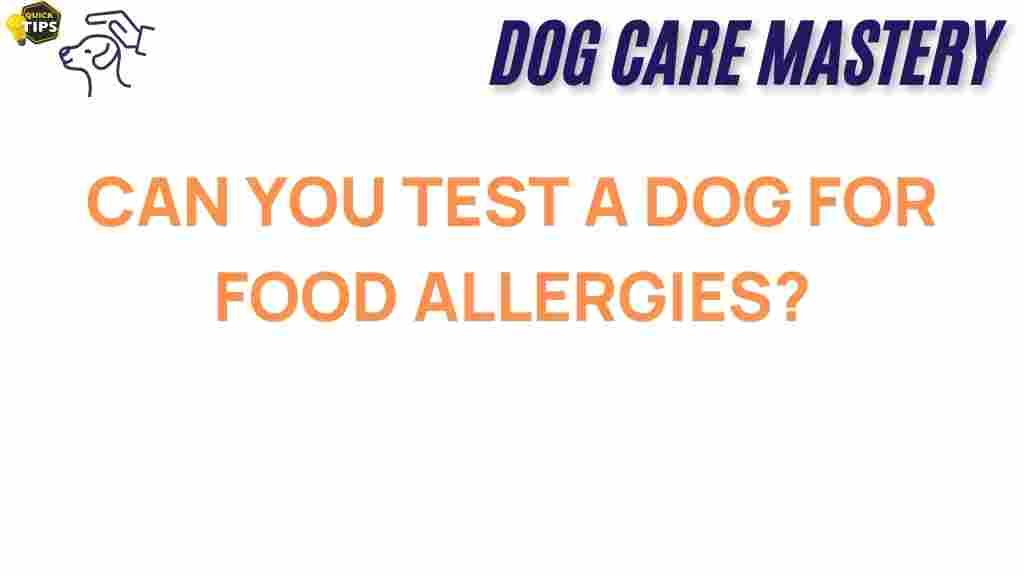Unraveling the Mystery: Can You Really Test a Dog for Food Allergies?
Dog food allergies can be a perplexing issue for pet owners. As our furry companions communicate their discomfort through symptoms like itching, gastrointestinal upset, and skin irritations, many owners find themselves on a quest to determine the root of their dog’s problems. In this article, we will delve into the world of dog food allergies, exploring whether these allergies can be tested, the methodologies involved, and how to navigate the diagnosis and management of this condition effectively.
Understanding Dog Food Allergies
Before we dive into the testing methods, it’s essential to understand what dog food allergies are. A food allergy occurs when a dog’s immune system mistakenly identifies a specific protein or ingredient in their food as a threat. The immune system then mounts a response that can lead to various symptoms, including:
- Itchy skin
- Ear infections
- Gastrointestinal disturbances (vomiting, diarrhea)
- Chronic licking or biting of paws
- Swelling and redness
Common allergens include proteins like beef, chicken, dairy, wheat, and soy, but any ingredient can potentially trigger an allergic reaction. Understanding these triggers is crucial for managing dog food allergies effectively.
Can You Test for Dog Food Allergies?
The straightforward answer is: yes and no. While there are various methods to test for dog food allergies, not all are equally reliable or recommended. Here are the primary methods:
1. Elimination Diet
The most widely accepted method for diagnosing dog food allergies is the elimination diet. This involves feeding your dog a diet that contains a novel protein and carbohydrate source that they have never consumed before, such as:
- Venison
- Rabbit
- Sweet potatoes
The elimination diet typically lasts for 8 to 12 weeks. During this period, it is crucial to avoid any treats, table scraps, or flavored medications that could contain allergens. After the elimination phase, you slowly reintroduce previous food items one at a time to identify which ingredient causes a reaction.
2. Blood Tests
Some veterinarians may recommend blood tests to check for food allergies. These tests look for specific antibodies associated with food allergies. However, it’s important to note that the reliability of these tests is often debated. Many veterinarians believe that blood tests can lead to false positives, making them less useful for definitive diagnosis.
3. Skin Tests
Skin testing, similar to allergy testing in humans, is another method. This involves exposing your dog’s skin to various allergens and monitoring for reactions. However, like blood tests, skin tests are not typically used for diagnosing food allergies and are more suited for environmental allergies.
Step-by-Step Guide to Conducting an Elimination Diet
To help you effectively identify food allergies, here’s a structured approach to conducting an elimination diet:
- Consult Your Veterinarian: Always start by discussing your dog’s symptoms and potential food allergies with your veterinarian. They can provide guidance tailored to your pet’s needs.
- Select a Novel Protein and Carbohydrate: Choose a protein and carbohydrate that your dog has never eaten before. Look for high-quality, limited-ingredient dog food.
- Transition Slowly: Gradually transition your dog to the new diet over a week to avoid gastrointestinal upset.
- Monitor Symptoms: Keep a diary of your dog’s symptoms throughout the elimination phase. Note any changes in behavior or health.
- Reintroduce Foods: After the elimination period, slowly reintroduce one ingredient at a time, allowing several days between each new food.
- Evaluate Reactions: After each reintroduction, watch for any adverse reactions. If symptoms reappear, it may indicate an allergy to that food.
Troubleshooting Tips for Food Allergy Testing
If you’re navigating the complex world of dog food allergies, here are some troubleshooting tips to consider:
- Be Patient: The elimination diet requires time and consistency. Rushing through it can lead to inaccurate results.
- Document Everything: Keep a detailed record of your dog’s diet, symptoms, and any changes. This log will be invaluable for you and your veterinarian.
- Avoid Cross-Contamination: Ensure that your dog’s food and treats do not come into contact with allergens during the elimination phase.
- Consider Environmental Allergies: Sometimes, it may not be a food allergy at all. Consult your vet if you suspect environmental allergens.
- Follow Up Regularly: Regular check-ins with your veterinarian can help track progress and adjust the diet as necessary.
Managing Dog Food Allergies
Once you’ve identified the offending ingredient(s), managing your dog’s food allergies becomes a priority. Here are some strategies:
- Choose Hypoallergenic Foods: Look for dog foods specifically formulated for dogs with food allergies or sensitivities.
- Homemade Diets: Consider preparing homemade meals tailored to your dog’s specific dietary needs, but consult your vet or a pet nutritionist to ensure a balanced diet.
- Monitor Treats: Always check the ingredient list of any treats you give your dog. Consider making homemade treats from safe ingredients.
- Regular Vet Visits: Schedule regular check-ups with your veterinarian to monitor your dog’s health and make necessary dietary adjustments.
Conclusion
Understanding and managing dog food allergies is a journey that requires patience, diligence, and collaboration with your veterinarian. While testing for dog food allergies can be challenging, the elimination diet remains the gold standard for diagnosis. By carefully observing your dog’s reactions to different foods and maintaining open communication with your vet, you can successfully identify allergens and improve your dog’s quality of life.
For further information on dog food allergies, consider checking resources from reputable veterinary organizations or consulting your veterinarian. Remember, your dog’s health is worth the effort!
If you want to explore more related topics, check out our article on common symptoms of dog allergies.
For scientific insights and research on pet allergies, refer to studies available at the American Veterinary Medical Association.
This article is in the category Health and created by dogcaremastery Team
